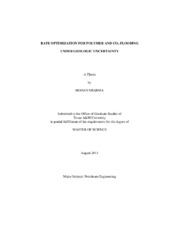| dc.description.abstract | With the depletion of the existing reservoirs and the decline in oil discoveries during the last few decades, enhanced oil recovery (EOR) methods have gained a lot of attention. Among the various improved recovery methods, waterflooding is by far the most widely used. However, the presence of reservoir heterogeneity such as high permeability streaks often leads to premature breakthrough and poor sweep resulting in reduced oil recovery. This underscores the need for a prudent reservoir management, in terms of optimal production and injection rates, to maximize recovery. The increasing deployment of smart well completions and i-field has inspired many researchers to develop algorithms to optimize the production/injection rates along intervals of smart wells. However, the application of rate control for other EOR methods has been relatively few.
This research aims to extend previous streamline-based rate optimization workflow to polymer flooding and CO2 flooding. The objective of the approach is to maximize sweep efficiency and minimize recycling of injected fluid (polymer/CO2) by delaying its breakthrough. This is achieved by equalizing the front arrival time at the producers using streamline time-of-flight. Arrival time is rescaled to allow for optimization after breakthrough of injected fluid. Additionally, we propose an accelerated production strategy to increase NPV over sweep efficiency maximization case. The optimization is performed under operational and facility constraints using a sequential quadratic programming approach. The geological uncertainty has been accounted via a stochastic optimization framework based on the combination of the expected value and variance of a performance measure from multiple realizations.
Synthetic and field examples are used extensively to demonstrate the practical feasibility and robustness of our approach for application to EOR processes. | en |


